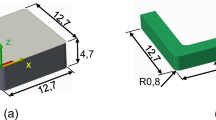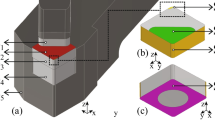Abstract
Nowadays, almost all cutting tools are coated due to improvements in manufacturing processes. The two main reasons are: (1) coatings allow a cut with less friction and less wear resulting in longer tool life and (2) thermal barrier effect, since the contact between workpiece–tool–chip occurs in the coating and not in the tool material (substrate). This paper analyzes, the thermal effect of the coating without considering the tribological effect. The thermal behavior with three types of coating: cobalt (Co), titanium nitride (TiN), and aluminum oxide (\(\hbox {Al}_2 \hbox {O}_3\)) on a ISO K10 carbide insert of 3 mm thickness was investigated. This paper investigates the behavior of inserts with coatings of thickness of 1, 2, 5, 10, and \(20\,\upmu\)m in a one-dimensional transient thermal model proposed for a material composed of two layers. A constant heat flux simulates the heat generated in the tool–piece–chip interface for coated and non-coated inserts. The solution of the diffusion equation is obtained using the Green function method. The effect of the coating can then be calculated by analyzing the evolution of the temperature at the cutting interface in contact with the heat flux and the evolution of the temperature at the coating–substrate interface. It can be concluded that coatings have thermal barrier effect, although for coatings of \(2\,\upmu\)m thickness, this influence is very small and produces temperature reduction of up to 14%. For thicknesses greater than \(5 \upmu\)m, the effect becomes considerable depending on the coating–substrate pair. In the case of TiN carbide, the temperature reduction is 26, 34, and 41% for the thicknesses of 5, 10, and \(20\, \upmu\)m, respectively.








Similar content being viewed by others
References
Beck J (1992) Heat conduction using Green’s functions. In: Computational and physical processes in mechanics and thermal sciences. Hemisphere Pub. Corp, USA
Brito RF, de Carvalho SR, Marcondes SM, Ferreira JR (2009) Análise térmica em ferramenta de metal duro revestida. In: Anais do Congresso Brasileiro de Engenharia de Fabricação, ABCM, Belo Horizonte, Minas Gerais, Brazil. http://www.abcm.org.br/anais/cobef/2009/busca/artigos/012003117.pdf
Du F, Lovell MR, Wu TW (2001) Boundary element method analysis of temperature fields in coated cutting tools. Int J Solids Struct 38(26–27):4557–4570. doi:10.1016/S0020-7683(00)00291-2
Grzesik W (1999) Experimental investigation of the cutting temperature when turning with coated indexable inserts. Int J Mach Tools Manuf 39(3):355–369. doi:10.1016/S0890-6955(98)00044-3
Grzesik W, Nieslony P (2004) Physics based modelling of interface temperatures in machining with multilayer coated tools at moderate cutting speeds. Int J Mach Tools Manuf 44(9):889–901. doi:10.1016/j.ijmachtools.2004.02.014
Grzesik W, Bartoszuk M, Nieslony P (2004) Finite difference analysis of the thermal behaviour of coated tools in orthogonal cutting of steels. Int J Mach Tools Manuf 44(14):1451–1462. doi:10.1016/j.ijmachtools.2004.05.008
Haji-Sheik A, Beck JV (2000) An efficient method of computing eigenvalues in heat conduction. Numer Heat Transf Part B Fundam 38(2):133–156
Haji-Sheikh A (2013) Two-layer slab with perfect contact between layers; with zero in heat flux at one boundary, zero heat flux at other boundary. http://exact.unl.edu. Accessed 5 July 2017
Haji-Sheikh A, Beck J (2002) Temperature solution in multi-dimensional multi-layer bodies. Int J Heat Mass Transf 45(9):1865–1877. doi:10.1016/S0017-9310(01)00279-4
Kaminise, A K, Guimarães, G, da Silva, M B (2014) Development of a tool–work thermocouple calibration system with physical compensation to study the influence of tool-holder material on cutting temperature in machining. Int J Adv Manuf Technol 73(5-8):735–747. doi:10.1007/s00170-014-5898-0
Machado AR, Abrão AM, Coelho RT, Silva MB (2011) Teoria da usinagem dos materiais. Edgard Blucher, Brazil
Özişik MN (1993) Heat conduction. Wiley, New York
Rech J, Kusiak A, Battaglia J (2004) Tribological and thermal functions of cutting tool coatings. Surf Coat Technol 186(3):364–371. doi:10.1016/j.surfcoat.2003.11.027
Rech J, Battaglia J, Moisan A (2005) Thermal influence of cutting tool coatings. J Mater Process Technol 159(1):119–124. doi:10.1016/j.jmatprotec.2004.04.414
Acknowledgements
The authors would like to thank the government agencies CAPES, CNPq, and FAPEMIG by the financial support of this project in the form of research grants and scholarships.
Author information
Authors and Affiliations
Corresponding author
Additional information
Technical Editor: Francis HR Franca.
Rights and permissions
About this article
Cite this article
Oliveira, G.C., Fernandes, A.P. & Guimaraes, G. Thermal behavior analysis of coated cutting tool using analytical solutions. J Braz. Soc. Mech. Sci. Eng. 39, 3249–3255 (2017). https://doi.org/10.1007/s40430-017-0848-z
Received:
Accepted:
Published:
Issue Date:
DOI: https://doi.org/10.1007/s40430-017-0848-z




